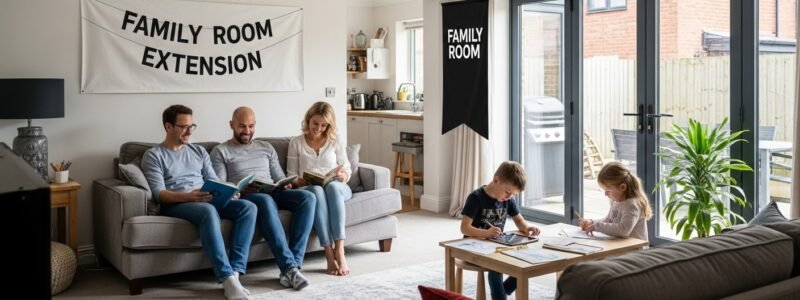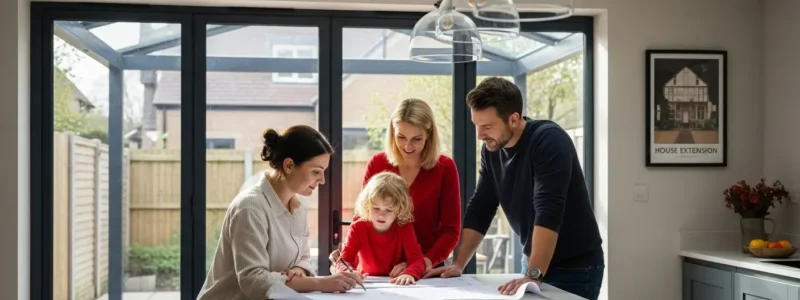Did you know that a carefully planned kitchen extension can increase your home’s value by up to 20 percent? Many families feel squeezed by cramped layouts or lack of natural light, and the right extension offers a real solution. Thoughtful planning, smart investment, and clever design can transform your kitchen into a bright, functional space where everyone loves to gather.
Table of Contents
- Understand Your Goals Before Extending
- Planning Permission And Legal Essentials
- Effective Budgeting For Kitchen Extensions
- Design Choices That Maximise Space
- Choosing Durable And Stylish Materials
- Managing Construction: Timelines And Disruption
- Boosting Home Value With A Quality Finish
Quick Summary
| Takeaway | Explanation |
|---|---|
| 1. Clearly define extension goals. | Understanding your needs helps avoid costly mistakes and ensures the extension meets your lifestyle requirements. |
| 2. Research planning permission needs. | Knowing when you need permission can save time and avoid legal challenges during your extension process. |
| 3. Create a comprehensive budget. | A detailed budget with contingencies helps manage costs and prevents financial stress associated with unexpected expenses. |
| 4. Maximize space with clever design. | Strategic use of natural light and open layouts creates a functional, inviting kitchen that enhances your home’s appeal. |
| 5. Focus on quality materials for value. | Selecting durable and stylish materials increases functionality and boosts your property’s market value, appealing to future buyers. |
1. Understand Your Goals Before Extending
Kitchen extensions are more than just additional square metres. They represent a significant investment in your home’s functionality and lifestyle. Before picking up a hammer or calling a contractor, you need a crystal clear understanding of why you want this extension and what specific problems it will solve.
Start by asking yourself fundamental questions about your current kitchen space. Are you struggling with limited cooking area? Do you need more natural light? Are you hoping to create a multifunctional space where family can gather and meals can be prepared simultaneously? According to research from Ideal Home, evaluating whether an extension is truly necessary or if reconfiguring existing space might suffice is a critical first step.
Key Considerations Before Extending:
- Assess your family’s specific lifestyle needs
- Determine precise functional requirements
- Calculate potential budget implications
- Evaluate natural light and spatial flow
Consider a practical approach. Sometimes, minor reconfigurations can achieve similar results at a fraction of the cost. A wrap around extension offers considerable potential, but must be carefully planned to address practical, structural, and financial factors.
Your kitchen extension should solve existing problems while creating a space that feels natural and integrated with your home. Take time to sketch layouts, discuss with family members, and visualise how the new space will function. By understanding your goals upfront, you prevent costly mistakes and ensure your extension truly enhances your living environment.
For comprehensive guidance through this planning process, check out our extension project management workflow guide which can help you navigate these crucial initial steps with confidence.
2. Planning Permission and Legal Essentials
Navigating the legal landscape of kitchen extensions can feel like traversing a complex maze. Understanding planning permission requirements is not just bureaucratic paperwork it is a critical step that can save you significant time, money, and potential legal complications.
Planning permission is not always mandatory but knowing when you need it becomes crucial. According to research from planning experts, installing a new kitchen typically does not require planning permission unless it involves structural changes or is part of an extension. However, the nuances can be intricate and location specific.
Key Legal Considerations:
- Assess whether your proposed extension falls under permitted development rights
- Understand local authority specific regulations
- Determine if your property has any unique restrictions
- Verify requirements for listed or conservation area properties
For properties in specific zones or with unique characteristics like listed building status, consulting with local planning authorities becomes essential. Professional architectural or planning consultants can provide targeted guidance tailored to your specific situation.
Proactive Steps to Navigate Planning Permission:
- Research local council guidelines
- Prepare detailed architectural drawings
- Engage with planning departments early
- Consider potential neighbourhood impact
Mistakes in this phase can lead to costly delays or potential enforcement actions. By understanding the planning permission requirements upfront, you protect your investment and ensure a smooth extension process.
Remember that regulations can vary significantly between different local authorities. What works in one borough might require extensive permissions in another. Taking time to understand these legal essentials will prevent future headaches and transform your kitchen extension journey from potentially stressful to strategically smooth.
3. Effective Budgeting for Kitchen Extensions
Budgeting for a kitchen extension is more than just crunching numbers it is about strategic financial planning that balances your dream space with economic reality. Understanding the true costs and potential financial pitfalls can save you from unexpected financial stress and project delays.
According to research from the Federation of Master Builders, an average kitchen extension in London can cost around £1,700 per square metre. However, these costs can fluctuate significantly based on project complexity, location, and design choices. This means a seemingly straightforward project could quickly escalate without careful financial management.
Strategic Budgeting Principles:
- Create a comprehensive budget with realistic contingencies
- Include a minimum 15% buffer for unexpected expenses
- Prioritise essential elements over aesthetic extras
- Get multiple detailed quotes from reputable contractors
Planning your layout and storage solutions before finalising the budget can prevent costly modifications later. Think of your budget as a living document that requires continuous refinement and honest assessment.
Cost Breakdown Strategies:
- Itemise every potential expense
- Research material costs thoroughly
- Consider long term value over immediate savings
- Factor in potential disruption to daily life
Some homeowners make the mistake of focusing solely on construction costs while overlooking associated expenses like temporary kitchen arrangements, potential storage needs, or minor structural modifications.
To maintain financial control throughout your project, consider using our guide on keeping home extensions on budget. This approach transforms budgeting from a stressful exercise into a strategic planning tool that empowers you to create your dream kitchen without financial anxiety.
4. Design Choices That Maximise Space
Transforming your kitchen extension from a mere architectural addition to a functional masterpiece requires strategic design thinking. It is not just about adding square metres but creating a space that feels open, inviting, and seamlessly integrated with your existing home.
Natural light plays a pivotal role in making spaces feel larger and more welcoming. According to design experts, strategic use of glass can dramatically transform your kitchen extension. Large sliding doors and overhead rooflights can flood the room with daylight, creating an illusion of expanded space and connecting indoor and outdoor environments.
Space Maximisation Strategies:
- Incorporate multiple light sources
- Use reflective surfaces to enhance brightness
- Choose streamlined furniture designs
- Consider open plan configurations
A wrap around extension offers an exceptional opportunity to reimagine your living space. By combining rear and side additions, you can create an expansive open plan area that dramatically increases floor space and improves natural light penetration. This design approach allows for flexible living zones that adapt to your familys changing needs.
Design Elements That Create Space:
- Minimalist cabinetry with hidden storage
- Floor to ceiling windows
- Neutral colour palettes
- Multi functional furniture pieces
Thinking beyond traditional boundaries can unlock incredible potential. For instance, incorporating sliding or pocket doors can create seamless transitions between spaces, making your extension feel more spacious and interconnected.
For more inspiration on creating smart, adaptable spaces, explore our guide on modern extension design ideas. Remember, brilliant design is not about how much space you have but how cleverly you use it.
5. Choosing Durable and Stylish Materials
Materials are the backbone of any successful kitchen extension. They are not just aesthetic choices but critical decisions that impact functionality, longevity, and overall home value. Selecting the right materials requires a thoughtful balance between style, durability, and practicality.
Design experts recommend using reflective and light-colored materials to maintain brightness and create a sense of spaciousness. According to research from interior design professionals, your material choices can dramatically transform the atmosphere of your kitchen extension, making it feel larger and more inviting.
Material Selection Priorities:
- Prioritise long term durability
- Consider maintenance requirements
- Match materials to your lifestyle
- Balance aesthetic appeal with practical performance
In a wrap around extension, material selection becomes even more critical. Your chosen materials should not only complement the existing structure but also enhance natural light and create a cohesive visual narrative. Quartz worktops, for instance, offer incredible durability while providing a sleek, modern appearance that reflects light beautifully.
Smart Material Choices:
- Ceramic tiles for easy cleaning
- Engineered wood for moisture resistance
- Stainless steel for high traffic areas
- Tempered glass for enhanced light transmission
Consider the practical demands of your space. A family with young children will have different material requirements compared to a couple who enjoy occasional cooking. Soft close cabinets, scratch resistant surfaces, and stain resistant fabrics can make a significant difference in long term satisfaction.
For deeper insights into creating a stunning yet functional space, explore our guide on modern extension design ideas. Remember that brilliant design is about making informed choices that serve both your aesthetic desires and practical needs.
6. Managing Construction: Timelines and Disruption
A kitchen extension is not just a construction project it is a significant life event that will temporarily transform your home environment. Understanding and preparing for the inevitable disruptions can mean the difference between a stressful experience and a smooth renovation journey.
Research indicates that a wrap around extension typically takes 4 to 6 months to complete. This timeline can feel like an eternity when you are living through the construction process. Careful planning becomes your most valuable tool in navigating this potentially challenging period.
Preparation Strategies:
- Create a detailed project timeline
- Establish clear communication with contractors
- Plan alternative cooking and living arrangements
- Set realistic expectations for completion
If you are planning to stay on site during the renovation, setting up a temporary kitchen is crucial. This might involve relocating your refrigerator, microwave, and essential cooking equipment to a different area of your home. Consider investing in portable cooking solutions like electric hobs or slow cookers to maintain some semblance of normal meal preparation.
Minimising Disruption Tactics:
- Designate specific work zones
- Protect remaining living spaces
- Schedule noisy work during convenient times
- Establish daily communication protocols
Mental preparation is equally important. Understand that unexpected challenges may arise, and flexibility will be your greatest asset. Some days will be noisier, some weeks might see slower progress than anticipated. Maintaining open dialogue with your construction team helps manage expectations and reduces potential stress.
For a comprehensive understanding of what to expect, explore our guide on understanding extension project timelines. Remember that every disruption is a step closer to your dream kitchen.
7. Boosting Home Value with a Quality Finish
A kitchen extension is not just a home improvement project it is a strategic investment that can significantly enhance your property’s market value. The difference between a standard renovation and an exceptional transformation often lies in meticulous attention to detail and thoughtful design choices.
Research from property experts reveals that a well executed wrap around extension can dramatically boost property value by adding substantial floor space and improving natural light. Potential buyers are increasingly drawn to homes that offer seamless, functional living spaces with a contemporary aesthetic.
Value Enhancing Design Strategies:
- Focus on high quality material selections
- Prioritise natural light integration
- Create multifunctional living areas
- Maintain architectural cohesion
- Invest in timeless design elements
Incorporating design elements that maximise natural light becomes crucial. Large sliding glass doors, strategically placed rooflights, and reflective surfaces can transform a basic extension into a bright, inviting space that feels significantly larger than its actual square footage.
Investment Focused Finishing Touches:
- Choose neutral colour palettes
- Select durable yet elegant materials
- Ensure seamless integration with existing architecture
- Consider energy efficiency features
- Add smart storage solutions
Remember that potential buyers are looking for more than just additional space. They want a thoughtfully designed area that feels like a natural extension of the home. This means paying attention to small details like consistent flooring, coordinated colour schemes, and intelligent spatial planning.
For deeper insights into making smart home improvements, explore our guide on home extensions that add value. Your kitchen extension is not just a renovation it is a long term investment in your property’s future.
Below is a comprehensive table summarizing the key considerations and strategies for kitchen extensions as discussed throughout the article.
| Aspect | Key Points & Actions | Benefits/Outcomes |
|---|---|---|
| Understanding Goals | Assess lifestyle needs, determine functional requirements, and evaluate spatial flow. | Prevent costly mistakes, enhance living environment. |
| Legal Essentials | Check planning permission needs, understand local regulations, consult experts if necessary. | Avoid legal issues, save time and money. |
| Budgeting | Create a comprehensive budget, include contingencies, get multiple quotes. | Avoid financial stress, manage project costs effectively. |
| Design Choices | Use natural light, open plan designs, reflective surfaces. | Maximise space, create inviting and integrated areas. |
| Material Selection | Focus on durability, maintenance, aesthetics. | Ensure functionality, longevity, and home value increase. |
| Managing Construction | Establish timelines, communicate with contractors, plan temporary arrangements. | Minimize disruption, ensure smooth project execution. |
| Boosting Home Value | Use high-quality materials, integrate natural light, focus on design cohesion. | Increase property market value, attract potential buyers. |
Transform Your Kitchen Extension Vision Into Reality
Are you wrestling with the challenges of outdated layouts, tight spaces, or a lack of natural light in your home? The lessons shared in ‘7 Key Lessons from Kitchen Extension Before and After Projects’ show just how important clear goals, smart budgeting, and careful design choices are when planning a kitchen extension. It can feel overwhelming to turn inspiration into a seamless, functional living space that genuinely adds value to your home. Many homeowners struggle to navigate planning permission, select durable materials, and keep their project on track and within budget.
Take the next step and turn what you have learnt into action. Explore even more ideas and tailored solutions in our Types of Home Extensions & Ideas and Extension Inspiration & Ideas for Your Home to discover what works best for your needs. When you are ready for expert support that guarantees transparency, proven project management, and a lasting, high quality finish, connect with us directly through our contact page. Now is the ideal moment to secure a kitchen extension that elevates both your lifestyle and your property value.
Frequently Asked Questions
What should I consider before starting a kitchen extension project?
Before starting a kitchen extension project, assess your specific lifestyle needs and how the extension will address them. Create a list of must-have features, budget considerations, and any zoning laws that might impact your design.
How can I effectively manage the budget for my kitchen extension?
To manage your kitchen extension budget effectively, create a detailed budget that includes all potential expenses and a minimum 15% contingency for unexpected costs. Regularly review and adjust your budget as needed, aiming to finalize major spending categories before construction begins.
What design elements can maximize space in my kitchen extension?
To maximize space in your kitchen extension, consider open-plan designs that incorporate natural light through large windows or sliding doors. Use streamlined furniture and minimalistic cabinetry to enhance functionality without overcrowding the area.
How long should I expect my kitchen extension to take?
Expect your kitchen extension project to take approximately 4 to 6 months, depending on the complexity of the design and construction. Establish a detailed project timeline with your contractors to help manage expectations and track progress.
What materials should I prioritize for durability and style in my extension?
Prioritize materials that balance durability and aesthetic appeal, such as quartz countertops and ceramic tiles. Focus on materials suited to your family’s lifestyle, considering maintenance needs and long-term value to ensure a smart investment.
How can I ensure my kitchen extension increases property value?
To enhance your kitchen extension’s potential to boost property value, focus on high-quality materials, natural light integration, and multifunctional design. Invest in timeless design elements and ensure a seamless architectural flow between the extension and your existing home.




